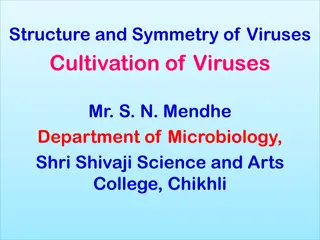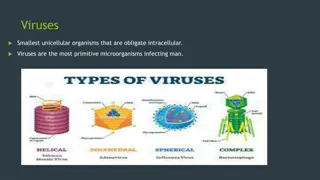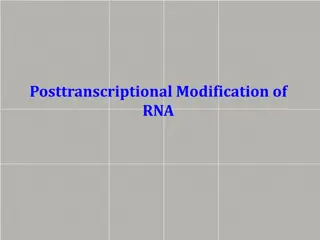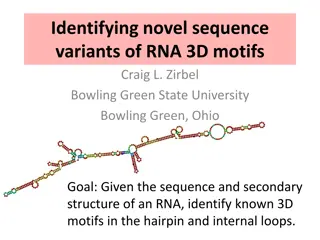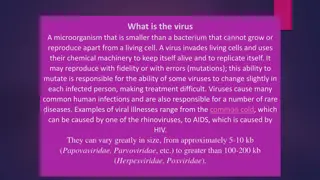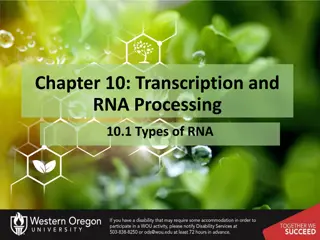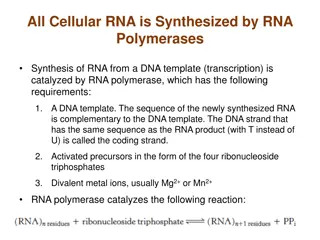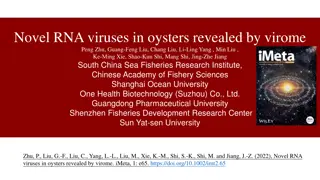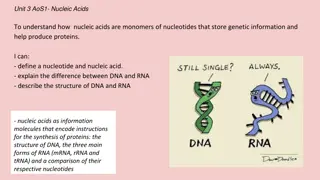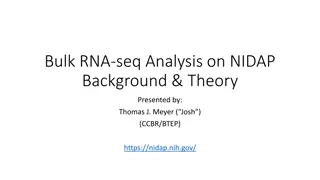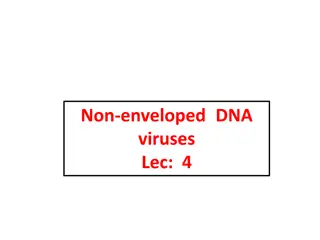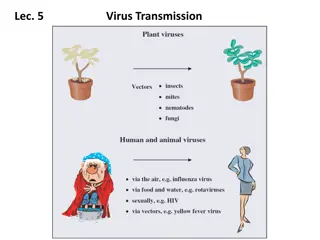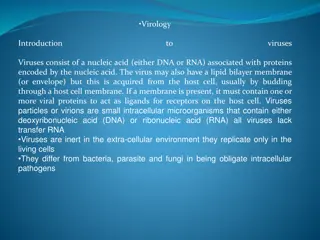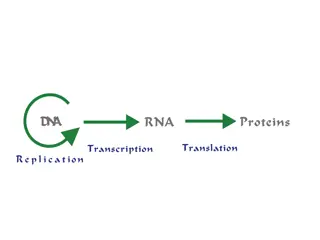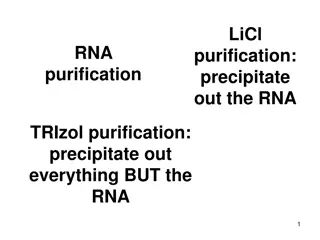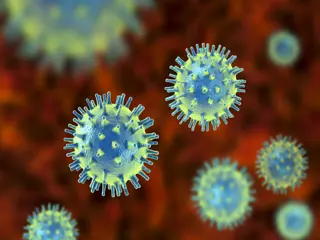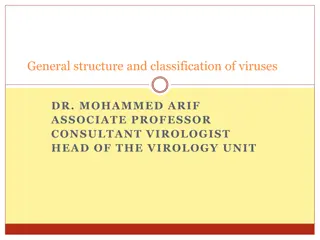Understanding Viruses, Viroids, and Prions: A Comprehensive Overview
Explore the fascinating world of viruses, viroids, and prions, from their discovery to their genetic material and hosts. Learn about the structure, genome, and sizes of viruses, as well as their interactions with different host cells. Gain insights into these acellular disease-causing agents and the
0 views • 17 slides
Understanding Gene Translation: From RNA to Protein
Gene translation from RNA to protein involves the specific binding of transfer RNA molecules to messenger RNA codons, enabling the translation of nucleotide sequences into amino acids. Each amino acid is attached to a specific tRNA through activating enzymes, and the anticodon on tRNA pairs with the
0 views • 4 slides
The Origin of Viruses: Theories and Evidence
Viruses are acellular parasites with a complex replication mechanism. Studies on their origin present challenges due to the lack of fossils. Three main hypotheses include regressive, cellular origin, and co-evolution. The regressive hypothesis suggests viruses originated from complex ancestors that
2 views • 25 slides
Understanding the Structure and Symmetry of Viruses along with Cultivation Methods
Viruses, defined as obligate intracellular parasitic organisms, exhibit general properties such as small size, filterability, simple structure, and absence of cellular components. They vary widely in size and lack independent metabolism. The cultivation of viruses plays a crucial role in studying th
3 views • 37 slides
Understanding 10X Single Cell RNA-Seq Analysis
This content delves into the intricacies of analyzing 10X single-cell RNA-Seq data, covering topics such as how 10X RNA-Seq works, evaluating CellRanger QC reports, dimensionality reduction techniques like PCA, tSNE, and UMAP, using the Loupe cell browser, and frameworks for scRNA analysis in R. It
0 views • 39 slides
Understanding Viruses: Basics and Morphology
Viruses are the smallest unicellular organisms that are obligate intracellular. They lack cellular organization like bacteria, and their multiplication is complex. Viruses have either DNA or RNA and are classified based on their nucleic acid. Their structure includes nucleic acid and a capsid compos
0 views • 29 slides
Posttranscriptional Modification of RNA Overview
A primary transcript is the initial RNA copy of a transcription unit, subject to posttranscriptional modifications like cleavage and further alterations to form functional tRNAs, rRNAs, and mRNAs. In eukaryotic cells, pre-rRNAs and pre-tRNAs undergo processing by ribonucleases to yield mature RNA sp
0 views • 12 slides
Understanding Computer Viruses: Types, Prevention, and Top 5 Destructive Viruses
Computer viruses are malicious software programs that can cause significant harm. Learn about different types of viruses, symptoms of infection, stages of a virus, prevention measures, and the top 5 most destructive viruses of all time.
0 views • 11 slides
RNA 3D Motif Analysis: Novel Sequence Variants Identification
A research project at Bowling Green State University aims to identify 3D motifs in RNA hairpin and internal loops using sequence and secondary structure information. The study focuses on finding likely sequence variants of known motifs, leveraging geometric considerations and basepair isostericity f
0 views • 28 slides
Understanding Computer Viruses: Threats and Categories
Learn about computer viruses, their history, classification, and impact. Explore different types like file viruses, polymorphic viruses, and stealth viruses. Understand the categories based on impact and discover macroviruses related to office applications.
1 views • 47 slides
Understanding Viruses: Origin, Structure, and Importance in Research
Viruses are microscopic organisms that rely on living cells to replicate and cause a range of illnesses in humans, animals, and plants. Studying viruses has led to significant scientific breakthroughs, providing insights into essential biological mechanisms and disease processes. Theories on the ori
0 views • 20 slides
Understanding Viruses and Bacteria: A Biology Presentation by Mandie Lynn Walls
Explore the world of viruses and bacteria through this engaging biology presentation put together by Mandie Lynn Walls. Learn about the structure of viruses, different types of viruses like T4 Bacteriophage and Herpes Virus, the distinction between viruses and bacteria such as E. coli, vaccination m
0 views • 39 slides
Understanding Transcription and Translation in Protein Synthesis
Protein structure is composed of amino acids arranged in specific orders to form polypeptides. This process involves transcription of DNA into RNA followed by translation of RNA into proteins. Replication plays a crucial role in preparing DNA for cell division. The central dogma of molecular biology
0 views • 24 slides
Understanding DNA Transcription and Translation in Biology
DNA transcription is the process where DNA is used as a template to create mRNA in the nucleus. This mRNA is complementary to the DNA and goes through initiation, elongation, and termination stages. RNA polymerases are essential for this process in eukaryotes. Various RNA polymerases have specific f
0 views • 47 slides
Understanding Transcription in Biochemistry
Transcription is a crucial process where RNA is synthesized from DNA, involving complex steps of initiation, elongation, and termination. This process is regulated by specific DNA regions, proteins, and enzymes like DNA-dependent RNA polymerase. The differences between DNA and RNA synthesis lie in t
0 views • 15 slides
Overview of RNA Transcription Process
The process of RNA transcription involves three main stages: initiation, elongation, and termination. Initiation starts with RNA polymerase binding to a promoter, followed by the formation of a transcription initiation complex. Elongation involves RNA polymerase untwisting the DNA helix and adding n
0 views • 17 slides
Understanding Transcription and RNA Processing in Molecular Biology
Explore the intricate processes of transcription and RNA processing in molecular biology, delving into the types of RNA molecules, the differences between DNA and RNA, RNA polymerase enzymes, transcription factors, and the preinitiation complex. Visual aids and detailed descriptions help elucidate t
0 views • 55 slides
Understanding RNA Polymerases and Transcription Process
RNA polymerases play a crucial role in synthesizing cellular RNA through transcription, where RNA is created from a DNA template. This process involves specific requirements such as a DNA template, ribonucleoside triphosphates, and divalent metal ions. RNA polymerase catalyzes the initiation and elo
0 views • 15 slides
Novel RNA Viruses in Oysters Revealed by Virome Study
Oysters, as high-yield mariculture varieties, were investigated for novel RNA viruses using virome analysis. Eighteen new RNA viruses were identified, with evidence of genetic recombination. This study highlights the importance of advanced sequencing technologies in discovering viral pathogens in aq
0 views • 11 slides
Safety and Efficacy of RNA in Human Diet and Agricultural Crops
RNA is a common component of the human diet, with naturally occurring RNAi mechanisms in various organisms. While staple foods contain RNA, barriers in the human body limit systemic exposure, making oral ingestion ineffective for RNAi. Studies have shown minimal bioavailability and efficacy of dieta
0 views • 9 slides
Insights into RNA Secondary Structure Prediction by Kieran Andrews
Explore RNA secondary structure prediction methods and results, highlighting the role of tRNA and rRNA in cellular RNA composition. The process involves cycling through sequence folds, scoring based on base alignments, and identifying cis-regulatory elements. Results showcase paired bases in tRNA an
0 views • 7 slides
Exploring RNA Secondary Structure Prediction in Bioinformatics
RNA secondary structure prediction is a key concept in bioinformatics, encompassing features like stems, loops, and bulges. This presentation delves into the importance of RNA beyond mRNA, highlighting rRNA, tRNA, and regulatory RNA roles. The canonical base pairs A-U and C-G shape the single-strand
0 views • 20 slides
Understanding Nucleic Acids and RNA Molecules
Nucleic acids are linear polymers composed of nucleotides, with DNA and RNA being the main types. RNA consists of messenger RNA (mRNA), transfer RNA (tRNA), and ribosomal RNA (rRNA), each playing a crucial role in protein synthesis. mRNA carries genetic information from DNA to ribosomes, tRNA transf
0 views • 8 slides
Overview of Myxoviruses: Classification, Morphology, and Orthomyxoviridae
Myxoviruses are a group of viruses that bind to mucin receptors on red blood cells, causing hemagglutination. They are classified into orthomyxoviridae and paramyxoviridae, with influenza viruses being major pathogens. Influenza viruses consist of three genera and have distinct morphological feature
0 views • 25 slides
Understanding Nucleic Acids: DNA, RNA, and Nucleotides
Nucleic acids are essential molecules that store genetic information and aid in protein production. This content delves into the monomeric structure of nucleotides, the differences between DNA and RNA, the unique characteristics of DNA's double helix structure versus RNA's single-stranded form, and
0 views • 11 slides
Unveiling the Intriguing World of Ancient Retroviruses and Human Evolution
Exploring the fascinating realm of ancient retroviruses, evolutionary biologists are resurrecting extinct deadly viruses to study their impact on human evolution and modern diseases. By investigating the genetic material of viruses, particularly endogenous retroviruses, researchers aim to trace evol
0 views • 13 slides
Decades of Marine RNA Virosphere Research
Research spanning over two decades has delved deep into the marine RNA virosphere, shedding light on the complex marine ecosystem and the characteristics of RNA viruses. Discoveries in deep marine virus taxonomy have led to significant taxonomic changes and advancements in virus classification and g
0 views • 10 slides
Bulk RNA-seq Analysis: Basics and Downstream Insights
Bulk RNA-seq is a powerful method for analyzing gene expression in biological samples. This approach involves extracting and sequencing RNA to understand the presence and quantity of RNA molecules. The process includes steps like conversion to cDNA, sequencing reads, and downstream analysis over ann
1 views • 12 slides
Overview of Non-Enveloped DNA Viruses and Their Impact on Human Health
Non-enveloped DNA viruses are surrounded by a protein coat called a capsid, making them difficult to sterilize and highly resilient in various environments. This article explores the characteristics and impact of non-enveloped DNA viruses such as Adenoviruses, Papilloma and Polyoma Viruses, and Huma
0 views • 16 slides
Understanding Virus Transmission via Vectors
Viruses must be transmitted to new hosts for their survival. This transmission occurs through vectors like arthropods, which acquire and transmit viruses during feeding. The mechanism involves viruses attaching to the vectors' mouthparts or entering their circulatory system to reach salivary glands
0 views • 14 slides
Role of RNA in Biological Processes and Protein Synthesis
Ribonucleic acid (RNA) is a crucial polymeric molecule in various biological functions including coding, decoding, gene regulation, and expression. It works alongside DNA and plays a key role in protein synthesis. There are three major types of RNA - rRNA, tRNA, and mRNA, each with specific function
0 views • 5 slides
Understanding Viruses: A Brief Overview of Virology
Viruses are small intracellular microorganisms consisting of nucleic acid and proteins, often enclosed in a lipid bilayer membrane acquired from host cells. They lack cellular structure and organelles and rely on host cells for replication. Control measures for viruses include leveraging knowledge o
0 views • 20 slides
Understanding DNA, RNA, and Transcription Process
The content delves into the intricacies of DNA and RNA, highlighting the significance of DNA safety in the nucleus, the role of RNA in protein synthesis, different types of RNA, the transcription process, and the importance of RNA in genetic information transfer. It also discusses how DNA is transcr
0 views • 35 slides
Understanding DNA, RNA, and Protein Synthesis: A Comprehensive Review
Explore the fundamentals of DNA, RNA, and protein synthesis in this detailed review. Learn about the structure of DNA, the role of different nucleotides, DNA replication process, RNA structure, various types of RNA, transcription from DNA to RNA, and translation from RNA to protein. Dive into the wo
0 views • 16 slides
Methods for RNA Purification and Separation from DNA
Selective precipitation of RNA using Lithium Chloride (LiCl) and extraction with phenol at acidic pH are two common methods for separating RNA from DNA. LiCl forms a complex with RNA facilitating its precipitation, while acidic phenol solution helps stabilize RNA at pH 4-5 for extraction. TRIzol var
0 views • 7 slides
Overview of Different Types of Nucleic Acids in Viruses
Explore the diverse types of nucleic acids found in viruses, including ssDNA, dsDNA, ssRNA, dsRNA, single-stranded cyclic DNA, double-stranded cyclic DNA, single-stranded cyclic RNA, and double-stranded cyclic RNA. The provided images depict the various classifications, shedding light on the genetic
0 views • 10 slides
Understanding the Basics of Virology: Viruses, Viroids, and Prions
Virology explores the world of viruses, infectious agents with living and nonliving characteristics. Viruses, noncellular genetic elements, depend on host cells for replication and lack metabolic functions on their own. Viroids and prions are novel entities related to viruses. Viruses are classified
0 views • 31 slides
Arboviruses: A Comprehensive Overview of Arthropod-Borne Viruses
Arboviruses, transmitted by bloodsucking arthropods, are a diverse group of RNA viruses with varied classifications like Togaviridae, Flaviviridae, Bunyaviridae, Reoviridae, and Rhabdoviridae. In India, Dengue, Chikungunya, and Japanese Encephalitis are prevalent arboviruses. Togaviridae, including
0 views • 70 slides
Understanding Nucleic Acids: DNA and RNA Overview
Nucleic acids, including DNA and RNA, are essential molecules storing genetic information for cellular functions. Comprised of nucleotides with nitrogenous bases, sugars, and phosphate groups, they play crucial roles in intracellular signaling, energy transfer, and genetic makeup determination. Ribo
0 views • 26 slides
Overview of Virus Structure and Classification
Viruses were first observed by Edward Jenner in 1798, who noticed their role in providing immunity. They are smaller than bacteria and consist of genetic material surrounded by a protein coat. Viruses are obligate cellular parasites, replicating only inside living cells. The structure of viruses inc
0 views • 38 slides



